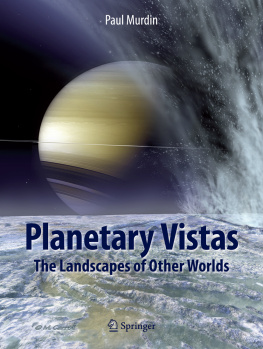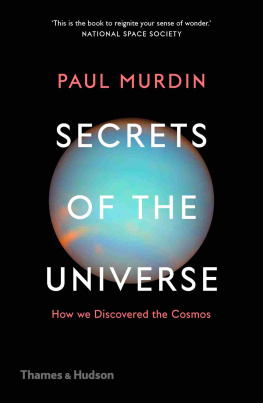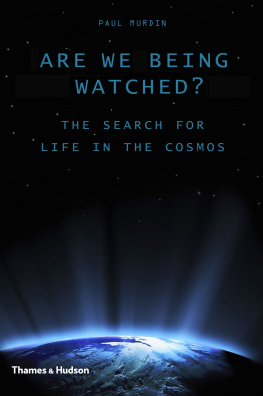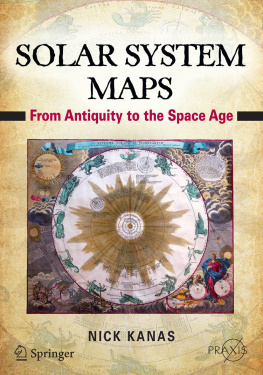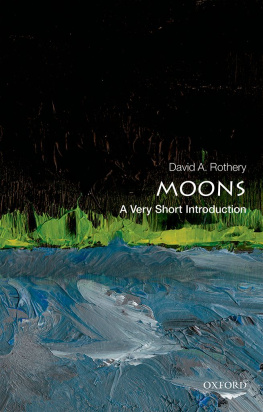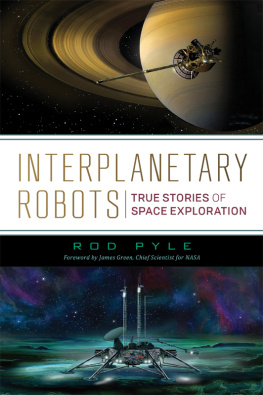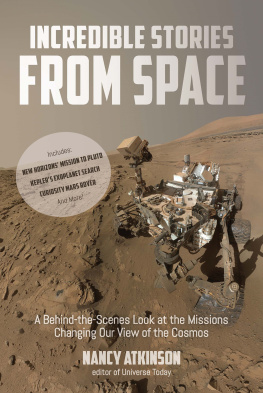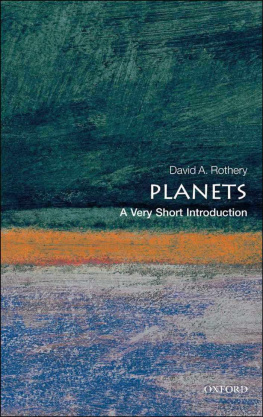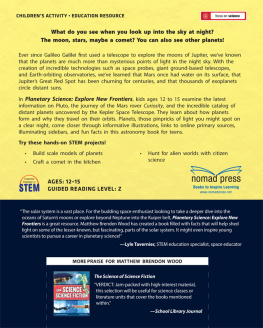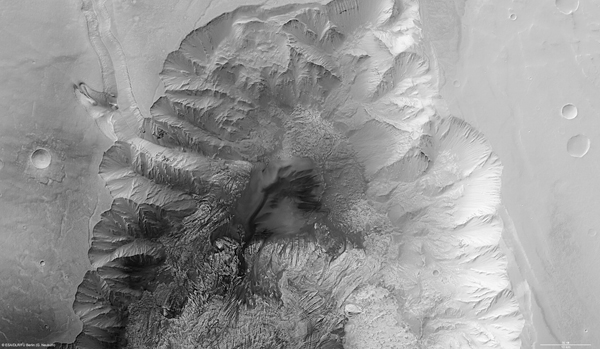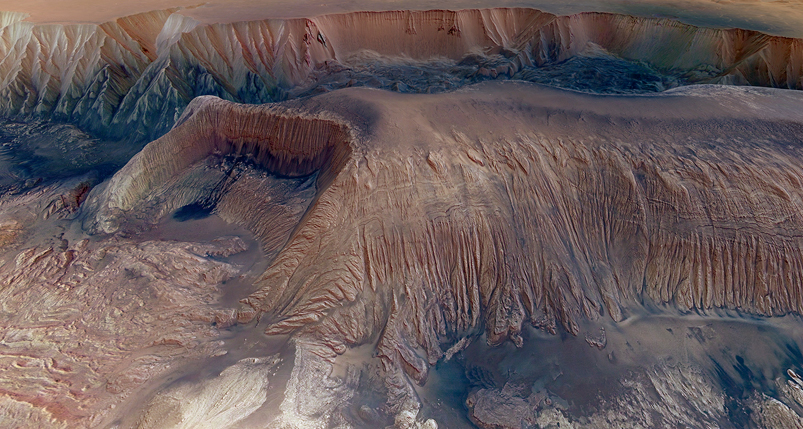1. Landscapes on Other Worlds
ALIEN LANDSCAPES
In 1543, on his deathbed, the Polish cleric Nicholas Copernicus (14731543) published his idea that Earth orbited the Sun, not the other way around. Earth was a planet. It was thus like the other planets of the Solar System. It was not somewhere special and different from everywhere else. The Dominican monk and philosopher Giordano Bruno (15481600) and the astronomer Johannes Kepler (15711630) immediately cast Copernicus proposition in its logical and symmetrical reverseif Earth was like a planet, the other planets were like Earth. This implied that the other planets were worlds like ours and probably had surfaces, as Earth does. Perhaps the other planets even had inhabitants. With the newly invented telescope, the astronomer Galileo Galilei (15641642) proved in 1610 that there was at least some truth in these assertions by discovering mountains and valleys on the Moon. The surface of the Moon was evidently similar to the surface of our own world.
Human beings, in person, have definitively proved that the Moon is like Earth by standing on the soil of its surface and picturing its hills, valleys and mountains. This is the only world outside Earth that has been proved by human experience to be terrestrial. However, by proxy, through the use of robots, humankind has explored, in close up and by physical presence, a number of the more distant worlds in the Solar System out to Saturns moon Titan. Through cameras landed on mobile robots, humans have been able indirectly to venture into and picture dramatic places on these worlds. Some planets of the Solar System have been further explored by remote mapping from orbiting satellites that produce files of scientific data that can be viewed as pictures.
All this effort has built up into a number of little-known but stunning planetary landscape pictures that represent what you would see if, as a space tourist, you visited these alien worlds. So far this is not possible in actual practice, but the pictures make it possible to be a space tourist without leaving ones armchair. In this book we explore these landscapes to view the beautiful scenery of other worlds, and also to understand the scientific reality that lies behind their landscape.
The exploration of the planets of our Solar System has been driven by scientific objectives, so the scenery is the focus of the interest, pictured for geological analysis. The pictures are usually taken from above, because most spacecraft are orbitersthey fly over and therefore look down on what they orbit over. You may well have had a similar experience as a passenger in an airplane. Looking out of the window, you can likewise look down on the country you are flying over. But, as everyone who has done it knows, what you see is tantalizingyou see the country in a fascinating and informative way, but you do not experience it. The view engages your curiosity but not your emotions.
To experience somewhere you have to visit and be immersed in the place. A large part of this experience is looking, so an image obtained by a camera is an approximation to the experience, which is why explorers, travelers and tourists take photographs to show others back home. But, unlike most spacecraft, people do not usually take pictures that look down (Fig. ). This is the view that we most often record as a souvenir, holding a camera up. In past times, before cameras had been invented and manufactured for a price everyone can afford, travelers might well have sketched the scene with pencil or painted it in watercolor or oils, to make a landscape picturesome travelers still do this. As human beings, looking horizontally is the way we understand scenery, a method that has developed as we have developed as a species. Photographs and pictures that represent what we see are the principal ways that we remember, investigate and re-experience the scenery after seeing it for the first time.
Fig. 1.1
Hebes Chasma. The region is an enclosed trough situated in Valles Marineris, the Grand Canyon of Mars . It is 800 km (600 miles) wide. It is a complex region created by the collapse of the surface and subsequent landslides into huge splits in Mars caused by upwelling due to volcanic activity below. This view looks straight down, as from an overflying aircraft or spaceship. (ESA/DLR/FU Berlin-G. Neukum.) B
Fig. 1.2
Hebes Chasma Mesa. Imaged by the High Resolution Stereo Camera of ESAs Mars Express , the central mesa inside Hebes Chasma is seen in close-up detail in this perspective view. a horseshoe-shaped valley has been created as material on one side of the mound (left in this image); has slumped down onto the floor of the valley below. Melted ice could have played a role by weakening the rocks of the mesa to create the flow-like appearance of the landslip. Loose material has slid down the walls of the valley from a dark intermediate layer to pool on the valley floor. Layers along the side of the mound are a mix of wind-blown dust and ancient lake sediments. This is the oblique view that a space tourist would have from within the scene, much more engaging than the view from flying over it and looking down vertically. (Mars Express: ESA/DLR/FU Berlin, G. Neukum.) BB
Artists have learned how to go beyond the mere recording of landscape. They simulate our human reaction to landscape by enhancing pictures of scenerysketches and paintingsin characteristically artistic ways. They capture the emotion of involvement in the land, by choosing the viewpoint, subject and scope of the scenery and presenting it through some interpretation of their own choosing. Their work has become important to us and our culturewe build great galleries to display landscape pictures on the walls, and pay sometimes enormous prices to acquire them for that purpose. The reason is that, somehow, an artists picture conveys more about the scenery than the mere facts. A landscape picture may speak of the beauty of the land, the awe that it inspires, and its meaning for us as humans. It may even speak about what lies in the scenerys past, or over the horizon in unseen lands beyond, or in its future.
Thus the word landscape has come to have two equally important meanings. Landscape is both the scenery and a picture of the scenery .
This book is principally about landscape pictures of other worlds and what they convey. In its elements, a planetary landscape picture is one that represents the scenery of another world as seen from a low viewpoint, near the ground, into a depth of field across the surface, looking horizontally.
Most of the planetary landscapes in this book have been made by men or spacecraft that have landed on the surface of another world. There have been about 40 missions in which spacecraft have landed on planets, and even roved over the planetary terrain. These missions have delivered many pictures of the scenery around them.
Some of the landscapes in this book have been made by men or spacecraft that have been in orbit but at low altitude, skimming the surface of a planet. This is a maneuver with its dangers. A small error of control or position, or an unforeseen technical glitch, could risk a crash. Low passes over the scenery are therefore not favored by cautious spacecraft controllers, especially flights over mountainous planets. Low-altitude flights are thus undertaken as a main part of a mission usually only on an approach to a landing in a flat area chosen to minimize dangers. But a low flight may be risked for some particular reason, perhaps in the last stages of a mission, after the main work has been completed. Landscape pictures from overflying spacecraft are therefore rare. But they are often very dramatic landscapes, of scenery that is otherwise inaccessible.

